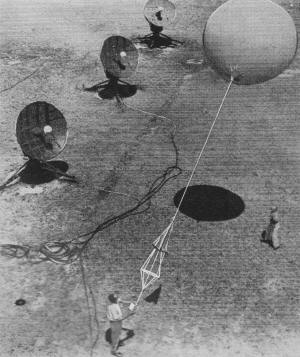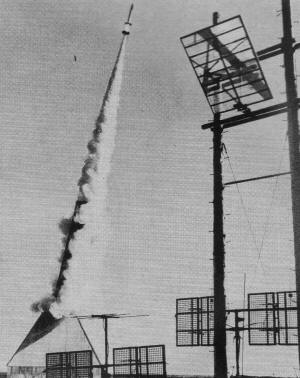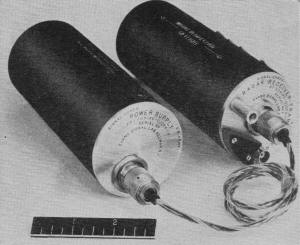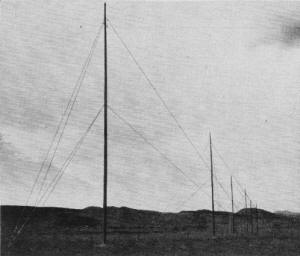Electronics and the IGY - Part I |
|
The International Geophysical Year (IGY) began on July 1 of 1957 and ran through December 31 of 1958 (actually IGYaaH - IG year-and-a-half). It was the dawn of space / high altitude flight and there was a great need to learn as much as possible about the physics of the upper atmosphere and the void of space. The USSR successfully flew their first three Sputnik satellites and the U.S. was scrambling to get Echo into orbit (finally on August 12, 1960, after the end of IGY). The Cold War was at its peak (Bay of Pigs incident was just a few years away), and the science world was looking for a way to provide a unifying tie between the planet's countries. "During this time, more than 5,000 scientists and engineers of more than 60 nations are conducting intensive investigation and study of the earth, the atmosphere and the sun. Into these 18 months are crammed 30 or 40 ordinary years of research as science attempts to get a better picture of our geophysical environment," per author Jordan McQuay. James Van Allen, one of the IGY's progenitors, discovered the eponymous radiation belt encompassing the Earth during that time. Electronics and the IGY Fig. 1 - This typical IGY observing station (Fritz Peak, Colorado) houses a photoelectric photometer and other optical equipment. Part I: Electronics contributes to the success of the International Geophysical Year By Jordan McQuay One of the most significant scientific undertakings in the history of mankind is the IGY or International Geophysical Year. It began last July and continues until next December - a period of 18 months. During this time, more than 5,000 scientists and engineers of more than 60 nations are conducting intensive investigation and study of the earth, the atmosphere and the sun. Into these 18 months are crammed 30 or 40 ordinary years of research as science attempts to get a better picture of our geophysical environment. At more than 1,000 field stations, scientists and engineers are exploring every major land and sea area. They are studying the earth's core and crust, and the atmosphere around our globe. And throughout these many and diversified studies and explorations, electronics plays an important role. For only the science of electronics can detect, observe and measure many of the phenomena associated with the earth and the sun as they move through space. So great is this role of electronics that much of the success of the IGY depends directly on its use. The IGY program covers a dozen major areas of scientific activity. These include meteorology, aurora and airglow, geomagnetism, cosmic rays, glaciology, gravity, longitude and latitude determinations, oceanography, seismology, solar activity, and rocket and satellite studies of the upper atmosphere. Although the earth-satellite program is perhaps the most popularized, this is only one of the areas of scientific activity during the IGY. Fig. 2 - A rawin set - a radiosonde and directional radio receivers - used to collect meteorological data. Fig. 3 - An Aerobee-Hi rocket a few moments after launching. US Army Photographs In most of these areas, electronics is utilized in some way to detect, collect, measure and record data concerning the earth and its atmosphere. Through electronics, these data provide not only new basic knowledge but also applications in many fields of human interest - from transpolar air travel to better radio communications, air navigation and weather predictions. This, in essence, is the purpose of the IGY. And electronics is an important means of making many of these investigations possible. Meteorology With every advance of civilization, knowledge of the weather has grown more and more necessary. To cope with change in the weather, reliable predictions - particularly long-range predictions - are needed. One difficulty in predicting weather has been the lack of adequate data from the Arctic and Antarctic regions, which influence the world's weather. During the IGY two drifting and several fixed ground stations in the Arctic and more than 50 ground stations in the Antarctic have been established to collect data influencing the weather. For the first time in history, adequate meteorological coverage of the Southern Hemisphere is being provided. At these various ice-bound sites, balloon-borne weather instruments are sent aloft and radio back information on air pressure, temperature, humidity, precipitation and prevailing winds. Radiosonde and rawinsonde equipment provide this data at heights up to about 100,000 feet. At each site, information is collected and then transmitted-via radio circuits - to central points for analysis and recording. In addition to the Arctic and Antarctic stations, there are more than a hundred other weather-observing stations in more temperate regions, particularly in the Western Hemisphere (Fig. 1). Stations are not identically equipped. A variety of electronic and other measuring instruments is used at many sites. Observations of solar radiation are made with pyrheliometers and recorders. Infrared measurements are made with infrared absorption-cell hygrometers. Sky brightness and sunshine duration are recorded with photometric switches. Atmospheric ozone is measured with Dobson spectrophotometers. Other ground-based devices detect and measure radiated sun heat, snowfall, wind and temperature. At selected sites throughout the world, the sun is photographed every 30 seconds. Radiosondes at Work Important to the study of meteorology at the various IGY sites is a continuous knowledge of wind direction and velocity, air temperature and humidity and other data from lower regions of the upper atmosphere. Instruments for recording these data are known as radiosondes and are carried aloft by balloons about 6 or 7 feet in diameter. Data collected by a radiosonde are broadcast to ground-based radio receivers for further analysis. Each radiosonde weighs about 2 pounds and is about the size of a hand telephone. Besides being a compact radio transmitter, it carries a thermometer, a hygrometer for measuring air humidity, a barometer and a miniature battery for a power source. After release, the balloon rises while the miniature transmitter flashes vital statistics to ground-based receiving stations. Each receiver automatically tracks the radiosonde and records the drift of the balloon as well as data transmitted by the radiosonde as it moves through space. A combination of a radiosonde and several ground-based receivers is known as a rawin (Fig. 2) or rawinsonde. The system operates up to altitudes of about 100,000 feet, when the balloon bursts. The radiosonde is then eased down by parachute to forestall possible injury to persons or damage to property. Most balloons and airborne gear are lost. But they have fulfilled their mission in meteorology for the IGY. Data collected by the rawin are sent by radio or wire lines to central control points, where they are recorded and analyzed further - usually by electronic data-processing machines. Data are stored on tapes or punched on cards and ultimately used for regional weather predictions. Although these data - collected at altitudes up to 100,000 feet - are important, for long-range weather prediction there is a need for similar data collected from much higher altitudes. Collection of such data is possible only by use of special rockets. The Upper Atmosphere Meteorological and other data are being collected from the upper atmosphere by four kinds of rockets: The Aerobee-Hi is a liquid-fuel rocket. In a 6-cubic-foot space, it carries a payload of 150 pounds of scientific equipment to an altitude of about 170 miles. It is 23 feet long and about 15 inches in diameter. The Nike-Cajun uses a solid propellant and carries a 40-pound payload to an altitude of more than 100 miles. The Nike-Deacon also uses a solid propellant to carry a 40-pound payload to an altitude of about 75 miles. Both rockets use the Nike as a booster. The Rockoon is a Deacon rocket carried to about 80,000 feet by a Skyhook balloon before the rocket is actually fired. It carries a 40-pound payload to an altitude of more than 60 miles. Of the dozen or so rockets fired to date, most were the Aerobee-Hi type. The majority of them were fired in the Arctic region. See Fig. 3. Particularly important in meteorology is the measurement of upper-air temperatures and the collection of air samples to determine their composition. This can be done with rockets, which also provide a way of determining wind speed and direction at heights never before possible. Temperature increases with increasing altitude because the ozone absorbs ultra-violet radiation. Thus, great out-bursts of ultra-violet radiation caused by a solar flare may result in temperature increases which are reflected at the earth's surface in marked weather changes. With these data, collected by the rocket and relayed to ground stations, much more accurate weather forecasting is possible. Two methods of measuring temperatures at high altitudes with rockets have been used successfully during the IGY. One system is based on the principle that the speed of sound is influenced by temperature. The speed of sound is measured through a series of small detonations that occur just outside the rocket housing at closely timed intervals during flight. Microphones on the ground detect each burst, and the exact time of arrival is recorded by electronic data-processing equipment. At the same time, radar and optical tracking equipment determine the exact location of each detonation in space as the rocket ascends. The position and time of arrival of each of the successive detonations indicate the speed of sound through the layer bounded by each burst. Thus, the mean temperature for each stratum of atmosphere can be determined electronically. Fig. 4 - Miniature radar-beacon transceiver (right) and its power supply for rockets used to explore the upper atmosphere. US Army Photographs Another method of temperature measurement requires knowledge of the angle made by the shock waves off the nose of the rocket during flight. These waves are detected by pressure-sensitive probes mounted on the outside of the rocket housing and, after amplification, are recorded on a magnetic tape inside the rocket. The data are also telemetered to a receiving station on the ground. From a knowledge of the fixed angle of the probes plus the location and speed of the rocket (determined by ground-based radar), the air temperature along the upward path of the rocket can be determined electronically. Air is sampled at high altitudes by sending special vacuum bottles aloft within a rocket. At predetermined altitudes, the containers are opened, and then closed and sealed by electromechanical devices. Rockets are also equipped with instruments to detect and record other phenomena under study during the IGY. Preliminary results during the IGY indicate that up to about 40 miles altitude, atmospheric gasses are completely mixed. Above that level, the amount of argon (a heavy gas) decreases and the amount of helium (a light gas) increases. Rockets in flight are located and tracked by ground-based radar stations and sound-ranging stations. Each rocket carries a small transponder beacon (Fig. 4) which transmits a return signal to IGY stations on the ground. Radar tracking also provides a measure of safety. If the rocket veers off course during its powered ascent, such a deviation is noted quickly by the ground-based radar equipment. If the behavior of the rocket becomes dangerously erratic, a change of signal is transmitted from the ground to the radio receiver in the rocket. This, in turn, breaks the fuel line and terminates the flight. To protect the delicate electronic instruments in the rocket from landing shock, they are carefully packed and braced. Some rockets are constructed so the nose and tail assemblies are blown apart during downward flight. A nylon parachute brings down the nose section that houses the electronic measuring and recording equipment. Most rockets carry out several different IGY experiments during a single flight. Thus the total number of flights is not indicative of the true importance of this phase of the IGY program. The several ground stations used to track and control the rocket are connected via communications circuits - using conventional radio or wire facilities. Collected data are evaluated and stored at central locations by electronic processing and storing equipment. Solar Activity Investigation of the upper atmosphere by radiosondes and rockets is supplemented by other IGY studies, all intended to enhance our knowledge of this region that surrounds us. The atmosphere - extending above 100,000 feet and thinning out into nothingness hundreds of miles above the earth - plays a dominant role in our lives. It provides a shield against lethal radiation from the sun and from dangerous cosmic radiation. It maintains the heat balance of the earth, so surface temperatures are suitable for life. And it affects our lives in many other ways. Under study during the IGY are events and conditions that take place more than 50 miles above the earth's surface. The sun dominates most of these events, which include aurora, airglow, cosmic rays, geomagnetism and other solar activities. Any unusual solar radiation - either in intensity or kind - influences the upper atmosphere. This, in turn, affects radio communication, navigational systems and other electronic activities dependent to some degree on the transmission and reception of electromagnetic waves through space. Solar activity is generally measured in terms of an 11-year sunspot cycle. Sunspot bursts or other active phenomena on the surface of the sun have lifetimes varying from a few days to a few months, invariably according to the 11-year time scale. Brief spurts of activity occur in some solar regions and may last from a few minutes to a few days. Variations in any of these solar activities frequently determine weather conditions on earth. For this reason, the IGY program was purposely timed to coincide with the peak of sunspot activity so that geophysical events in the upper atmosphere would be at their maximum. To observe these solar phenomena, a network of more than 400 ground-based stations has been established around the world. The stations are spaced to allow a continuous optical and electronic watch of the surface of the sun and the upper atmosphere. Events occurring in the visible as well as radio frequencies are measured and recorded. These include the number and size of sunspots, solar flares and solar (radio-frequency) noise - all correlated with time. At these and additional stations in the Arctic and Antarctic, aurora and airglow are also observed and recorded. Aurora or dancing light is the visible evidence of the bombardment of the earth's atmosphere by charged particles from the sun. It is a luminous trace, usually occurring near the north and south geomagnetic poles of the earth. Airglow is a faint glow of light, somewhat like aurora, caused by a chemical reaction in the upper atmosphere of Arctic and Antarctic regions. Both aurora and airglow interfere with radio communications. At IGY stations in polar regions, aurora and airglow are observed and recorded with radiosonde equipment associated with photoelectric photometers, scanning spectrometers and high-dispersion spectrographs. Photographs of aurora and airglow are taken at regular intervals with specially built automatic-sequence all-sky cameras - which cover the sky from horizon to horizon. Each instrument incorporates a 16-mm motion-picture camera which photographs the entire sky as seen in a convex mirror. Exposures are taken about once every 5 minutes. Data on auroral forms and intensities are classified and recorded electronically in terms of sky location and time, reduced to punched-card form and filed for future reference. This work is done by conventional electronic data-processing machines. During periods of marked solar activity, rockets are also used to obtain data for study and record. In airglow experiments, photon counters are encased in the rocket. These counters are used at various wavelengths in the visible spectrum with their output coupled to amplifiers containing photo-multiplier tubes and filters. Auroral articles - almost infinitesimal dust - are collected and measured with Geiger counters, proportional and scintillation counters, ionization chambers and related equipment mounted within the rocket. All data collected by rockets are recorded and then telemetered to ground-based receiving stations. When scientists cannot observe an aurora visually or photographically, the course of the aurora is followed with radar equipment. The path of an aurora can also be studied by means of radio and radio astronomy. The pattern of auroral interference with ordinary radio transmissions on the earth and with the arrival on earth of radio-frequency emissions from the sun and other planets provides valuable data for predicting radio propagation. Cosmic rays are other solar phenomena. Although their origin is a mystery, their presence can be detected and their characteristics examined. These are essentially positively charged particles that bombard the earth from all directions. Excessive bursts of cosmic rays frequently coincide with other ionospheric disturbances and are so severe that they not only interfere with but sometimes prevent radio communication. At the many IGY observation stations around the world, cosmic rays are studied with other solar activities. Used for this purpose are cloud chambers, ionization chambers, window Geiger counters, electronic impulse counters and other special instruments to detect and measure cosmic rays. Information is recorded in terms of time for later comparison with other solar disturbances and effects. Raw data are exchanged between IGY stations via radio communication - usually using high-speed teletype-writers. At key central stations, data from all observing points are correlated and recorded by electronic data-processing equipment. Ionosphere Physics A region of rarefied ionized gases - from 50 to 250 miles above the earth - is known as the ionosphere. It is electrically active because of ultra-violet radiation from the sun, and reflects radio waves from earth much as a mirror reflects light. For this reason, radio communication is entirely dependent on the ionosphere for long-distance transmission. Fig. 5 - Antenna array of an IGY observing station (Boulder, Colo.) used to study effects of the ionosphere on radio-wave propagation. National Bureau of Standards Photo The region is far from stable. It is composed of layers of ionization which change radically with time of day, with season, and even from year to year. Its radio-wave reflecting characteristics also vary with prominent solar activities. A flare on the sun is frequently followed by an ionospheric disturbance that blacks out all long-distance radio communication. Active sunspots and violent auroral displays also affect the ionosphere and result in major paralyses of long-distance communication. Through detailed study of the ionosphere and its many and varied characteristics, some of the mysteries of this ionized region may be deduced during the IGY. Observing stations are endeavoring to collect data on the characteristics of all layers or part of the ionosphere. Of particular significance are data on variations of charge density with altitude. Layers are measured vertically and obliquely from each observing station at regular intervals, using automatic multifrequency ionospheric recorders. This equipment normally sweeps from 1 through 25 mc in a period of about 20 seconds, and this sweep is repeated about every 20 minutes. Radar data are recorded on 35-mm film, which is processed and scaled daily for significant ionospheric characteristics. Rockets are also used to determine ionospheric charge densities in three ways: In the first, the delay time of an electromagnetic pulse sent from the ground station to the rocket is measured. In the second, two harmonically related signals are transmitted from the rocket in the ionosphere; with a known phase shift, the index of refraction in the vicinity of the rocket shell is a measure of the charge density. In the third, the charge density is determined from the effect of the ionosphere on DOVAP (Doppler, velocity and position) signals. Data are either recorded by electronic equipment within the rocket or raw information is telemetered to ground-based receiving equipment where it is recorded and analyzed. Nearly a hundred observing stations have been established at points around the world specifically for the purpose of measuring the position and density of layers of the ionosphere. Much of this work, particularly in the. Antarctic, has never before been attempted. Data of this type from all ionospheric and other observing stations are collected and assembled to obtain a worldwide pattern for prediction purposes. See Fig. 5. Other investigation of the ionosphere include the use of solar spectrographs, encased in rockets, to determine the distribution of ozone in the upper atmosphere. A radio-frequency mass spectrometer is used to measure the chemical and ion composition of the ionosphere. These plus wind and other measurement are either recorded electronically within the rocket or are transmitted to the ground observing stations for study and record. Another field of intensive study is the recording and measurement of atmospheric radio noises. At principal stations of the global IGY network, noise is recorded continuously, 24 hours a day, on magnetic tape, with appropriate time references for comparison with other meteorological data. Low-frequency or whistling atmospheric noise is the subject of a special study during the IGY in an effort to identify the origin and define the characteristics of this kind of radio interference. Other IGY studies relating to the ionosphere include investigation of oblique-incidence forward scatter, sweep-frequency back scatter, absorption and other phenomena relating to the propagation of radio waves. Any unusual solar or ionospheric activity in one region of the world is communicated to other IGY stations by a global radio network. This allows more intense study of the same phenomenon and its effects at various sites throughout the world. Next month - a look at the earth satellite and its place in the International-Geophysical Year. To Be Continued...
Posted August 1, 2019 |
|





